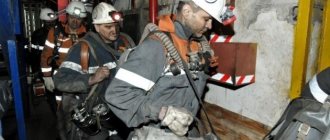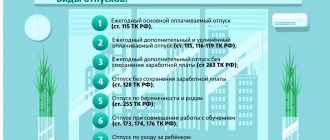Who is entitled to
The legislation establishes four levels of harmful factors. And working in unfavorable conditions of degrees 2, 3 and 4 means that employees receive additional rest. Employees of hazardous industries have the right to annual payment. The negativity of labor in an enterprise or workplace is established in one of the following ways:
- carrying out certification (results obtained no later than 01/01/2014 are taken into account);
- carrying out a special assessment.
The head of the organization must familiarize employees with the results of the audit no later than one month after its conduct.
In some institutions, additional leave for harmful working conditions is provided in accordance with adopted regulations. These documents contain information about positions in which a person faces disadvantage. Such organizations include, for example, law enforcement agencies.
Who is entitled to leave for harmful activities in 2021?
For employees who are busy:
- in harmful and (or) dangerous working conditions, confirmed by workplace certification carried out before January 1, 2014;
- in hazardous working conditions of 2, 3 or 4 degrees or in hazardous working conditions confirmed by a special assessment of working conditions carried out after January 1, 2014.
Harmful conditions usually mean activities where hygienic standards are significantly violated and the employee is forced to work in such conditions, after which he may develop serious occupational diseases or lose his ability to work.
Law
According to existing standards (Articles 116 and 117 of the Labor Code of the Russian Federation), the employer is responsible for providing additional leave to workers whose workplace is associated with negative factors. To do this, an assessment of working conditions must be carried out every 5 years .
IMPORTANT! Some situations require the employer to conduct an extraordinary special assessment. These are: an accident or the introduction of a new position in the staffing table.
According to federal law, namely Art. 14 from December 28, 2013 No. 426-FZ, a workplace can be assigned:
- Class 1 – acceptable conditions for work;
- Class 2 – working conditions are considered acceptable;
- Class 3 – the workplace is associated with harmful working conditions;
- Class 4 – the labor process poses a danger to the employee.
If an employee is hired for a position assigned grades 2-4, then he is entitled to additional leave in addition to the main one . You can obtain such information from the employer. Once the assessment is completed, the employee must sign the relevant document within one month.
Duration of rest
The question often arises, how long can vacation “for harmfulness” last? The Labor Code established the minimum duration of leave for hazardous working conditions - seven calendar days for each year.
The exact number of days allotted to an employee may be determined by:
- employment contract (the duration is determined based on an agreement within one industry or between several industries);
- collective agreement (when determining the duration, the assessment of jobs at the enterprise is taken into account);
- Soviet list (if, according to the new rules, the assessment of places was not carried out, and the enterprise still takes into account the results of certification).
A 1974 USSR document contains information about professions in which people are entitled to additional benefits. leave for hazardous working conditions, calculated in a specific number of days. Also see “How many days of vacation are required per year.”
What law established the Labor Code of the Russian Federation?
In general, Chapter 19 of the Labor Code is devoted to the process of providing regular paid vacations.
The minimum duration of the main part of the annual paid leave is established in Article 115 of the Labor Code of the Russian Federation.
Articles 116-119 of the Labor Code of the Russian Federation determine the duration and rules for providing additional vacation days.
The employer must strictly comply with the requirements of Labor legislation.
He is obliged to send his staff on vacation annually, must plan the vacation dates of all employees for the next year in the schedule, is obliged to retain the employee’s job for this period and pay him the average daily wage for each day of rest.
Rest for employees of temporary detention facilities and other categories
The Labor Code limits the minimum number of vacation days. The employer has the right to increase their number if the company has enough money to pay for rest days in excess of the norm.
The manager can change the number of vacation days upward:
- by issuing a special internal act on the organization;
- by stipulating the terms in the collective agreement.
Organizations operating in the same industry can draw up and accept an agreement to increase the number of vacation days for hazardous working conditions for a number of categories of employees. When establishing a specific period of rest, the harmful factors of work in specific specialties are assessed.
EXAMPLE
The Ministry of Internal Affairs issued an order with a list of specialists who receive additional days of rest “for harmful conditions” - order No. 549 dated June 30, 2014. Thus, temporary detention center employees have additional leave for harmful working conditions equal to 10 days a year. The rule applies to a number of positions named in this document.
Who can count on vacation for harmful activities?
A complete listing of positions and professions in which an employee must receive additional vacation days can be found in the List of industries, workshops, positions and professions with hazardous production factors. It was approved by the USSR State Statistics Committee back in 1974.
Currently, workers in the following industries are entitled to additional days of rest:
- mining industry;
- shale and oil and gas industry;
- work carried out underground;
- mining and processing;
- electrical power and chemical industries;
- microbiology;
- geological exploration;
- metallurgy, etc.
Types of days
An employee has the right to take both basic and additional vacations at once. The company's accountant must calculate the duration of each of them, and then add up the results. Also see “Calculation of leave for hazardous working conditions”.
An important nuance is the fact that the main leave is counted in calendar days, and the “harmful” leave is counted in working days. The Ministry of Labor for calculating additional rest is based on a six-day working week.
EXAMPLE
Let’s say an employee decides to take a basic vacation of 14 calendar days and additional days of 10 working days starting from 07/04/2018.
Therefore, the main vacation will end on July 17, 2018, and the additional vacation will end on July 30, 2018. Explanation: July 22nd and 29th are excluded from the extra. holidays as they fall on Sunday. The total duration of rest will in fact be not 24, but 26 calendar days.
How much has been accumulated?
The amount of additional leave “for harmfulness” depends on the amount of time worked. The accountant must calculate:
- the number of days actually worked in difficult conditions;
- the number of whole months of work in difficult conditions;
- the duration of the additional leave due.
If an employee has worked for at least 11 months in difficult conditions, then he is entitled to take off all the days provided for by law for the year.
Please note: an employee cannot receive vacation “for harmfulness” in advance!
After the calculation, the accountant must remember to convert the vacation received from working days to calendar days.
Vacation for irregular working hours
Irregular working hours are a special work regime, according to which individual employees may, by order of the employer, if necessary, be occasionally involved in the performance of their labor functions outside the established working hours. The list of positions of employees with irregular working hours is established by a collective agreement, agreements or local regulations adopted taking into account the opinion of the representative body of employees (Article 101 of the Labor Code of the Russian Federation).
Article 119 of the Labor Code of the Russian Federation provides that employees working in this regime are provided with annual additional paid leave, the duration of which is determined by a collective agreement or internal labor regulations and cannot be less than three calendar days. Let us remind you that the employer can increase the duration of additional leave in local regulations.
When providing this additional leave, the question may arise: is it possible not to provide it if the employee has never been involved in work outside the normal working hours? Rostrud responded to it in Letter dated May 24, 2012 N PG/3841-6-1. In particular, the department explained that the grounds for granting this additional leave are work on irregular working hours and the presence of the employee’s position in the list of positions of employees with irregular working hours, which is established by the collective agreement or the internal labor regulations of the organization. Since the law does not provide for the provision of leave for irregular working hours in proportion to the time worked in the working year, the employer is obliged to provide such leave, even if he has never engaged the employee to work beyond the normal working hours.
Paperwork
The HR department and/or accounting department of the enterprise processes additional leave. Tracking the fulfillment of the employer's obligations to employees is done using a leave sheet. Also see "Vacation Schedule".
When drawing up a vacation schedule in advance, the HR employee must calculate the number of days not only of the main vacation, but also of additional vacations. The duration is determined on the basis of Art. 120 Labor Code of the Russian Federation. Vacation days are summed up and recorded. If during the previous period the employee had unused vacation days, they are taken into account in the new rest schedule.
If the information about additional leave is not indicated in the schedule accurately (there is no specific date, but only a month) or the employee decides to take the due time off outside of it, then he must write an application addressed to the head of the organization, indicating:
- information about yourself - position and full name;
- basis – the right to leave for harmful working conditions (Article 117 of the Labor Code of the Russian Federation);
- number of rest days and start date;
- day of application.
The employee must sign at the bottom of the document. The finished application is accepted by HR specialists.
The same procedure is provided for those who started working in the organization after the vacation schedule was drawn up, but have the right to rest “for harm.”
Providing additional leave is permissible after drawing up the order. It can be drawn up in the T-6 form. The document must indicate the vacation period in calendar days and the start date. Also see “Sample vacation order”.
Information about additional rest is also entered into the working time sheet. The following codes are provided for such days:
- alphabetic – “OD”;
- digital – “10”.
If non-working holidays occur during the period of additional leave, they are not included in the leave itself and are marked “26”.
Features of receiving additional rest
If, due to the employee’s profession, there is a possibility of harm to health or danger to life, the employment contract must reflect the following:
- information about all risks and their classification;
- information on payment of compensation and provision of additional leave;
- a list of measures taken by the employer to preserve the health and life of its staff.
Advice! To determine who has the right to count on a grace period of rest, you should refer to the regulatory documentation. It clearly states the restrictions on performing job duties in an unfavorable environment, as well as an exhaustive list of professions that are recognized as harmful.
The first applies to the following persons:
- employees under 18 years of age;
- workers who have identified health problems;
- female employees.
The latter are reflected in Labor and federal legislation.
Who should
Lists of specialties that initially imply a harmful work environment are approved by the Russian Government. However, at this time, based on Article 423 of the Labor Code of the Russian Federation, other legal documents, as well as legislative acts of the former Soviet Union, only those categories that do not contradict the current Labor Code are taken into account.
Until 2014, additional leave was provided to everyone who was employed in hazardous production. But in the subsequent period and to this day after amendments were made to Art. 117 TK. Russian Federation, such a benefit has become available only to employees whose workplaces are assigned hazard levels 2, 3 and 4. At the same time, those specialists who worked in conditions corresponding to Article 1, and after the adoption of the amendments, retain the right to use additional days for recovery.
It should be noted that Federal Law No. 400-FZ recognized as relevant the Resolution of the USSR State Committee on Labor and Wages, the Presidium of the All-Union Central Council of Trade Unions No. 298/P-22 dated 10.25.74. These documents approved a list of positions and professions with hazardous working conditions that give the right to a shortened working day and additional leave, as well as instructions on the procedure for its application. Taking into account the above, we can conclude that the list of professions applying for additional leave for harmful working conditions includes workers:
- oil industry;
- metallurgical production;
- coal and mining industry;
- transport companies;
- laboratories where chemical and bacteriological products are produced;
- pulp and paper industry;
- producing chemicals;
- producing glass and porcelain products;
- manufacturing ammunition and interacting with gunpowder;
- located at facilities with high radioactive contamination;
- health workers in contact with HIV-infected and tuberculosis patients;
- divers.
There are a number of specialists who, by virtue of their profession, are entitled to claim additional days of rest, only on other grounds:
- workers with irregular work schedules;
- workers of the extreme northern regions;
- victims during the liquidation of the accident at the Chernobyl nuclear power plant;
- exposed to radiation during nuclear testing;
- employees of the Ministry of Emergency Situations;
- veterinarians;
- prosecutors;
- combat veterans;
- persons with disabilities.
This list should also include the profession of a gas or electric welder, who on certain days is involved in hazardous production and performs work recognized as hazardous to health. In this regard, a person has the right to claim an additional grace period of rest, which by law ranges from 6 to 12 working days.
Procedure and conditions of provision, rules of registration
In any company, at the end of each year, a schedule of annual paid vacations is drawn up for the upcoming calendar year. Additional days of rest for harmful activities are taken into account when determining the total duration of the vacation period. Since additional leave has a short period, it is advisable to arrange it in conjunction with the main one. If the annual period is divided into several parts, then days of rest for harmful activities are added to one of them.
In general, the Legislator takes workers who have to work in an unfavorable environment very seriously. They cannot be recalled to resume work ahead of schedule, even if he provides written consent.
At the same time, you can apply for additional leave only for the period that was worked in harmful conditions. This is confirmed by Art. 121 Labor Code of the Russian Federation. If an employee spends one part of the work shift in a comfortable microclimate, and the other (more than 50%) in an unfavorable environment, then he is also allowed to rest for a period established by management. In the process of forming the total duration of additional leave, the following is not taken into account:
- period of absence due to illness;
- leave taken in connection with pregnancy and upcoming childbirth;
- time allocated for caring for a baby up to 1.5 years old;
- work in easier conditions (during pregnancy);
- the period during which the employee performed government duties;
- other working hours when the subordinate was not engaged in hazardous work.
Registration takes place in the general manner, in accordance with the vacation schedule. The HR employee sends written notice to the employee 14 days in advance. The latter must write an application no later than a week in advance - this is the period required to calculate and pay compensation. The manager issues an order indicating the type of leave, its start and end dates. The additional period is also reflected in the time sheet. The employee receives funds no later than 3 days in advance and goes on vacation.
Calculation and payment procedure
Leave for harm to a subordinate is given in proportion to the time worked. When calculating its duration, only those periods when the work was associated with negative (hazardous) production factors are taken into account. The number of additional days is calculated in accordance with Art. 121 of the Labor Code of the Russian Federation, and provides for the following sequence.
It is important to know! Determination of actual days worked in a harmful area. This is done on the basis of Resolution of the USSR State Committee for Labor No. 298/P-2 or regulations and local documentation. The periods when the employee worked in an unfavorable environment are counted.
Determination of the number of complete years during which the employee was exposed to harmful conditions.
Initially, the average monthly number of days in the current year is calculated using the formula A=B/12, where B is the total amount of working days in the calendar year. Next, the number of complete harmful months at the time of going on vacation is determined. To do this, use the formula H=J/D.
J – the number of days that the subordinate worked in a harmful environment;
D – average monthly number of days in a calendar year.
Sometimes when calculating, a fractional value of the result is obtained. In this case, it is customary to round it up.
Determining the number of days of additional leave. If, based on the results of mathematical operations, it was found that the employee worked in an unfavorable production environment for less than eleven months, the following formula is used to calculate the rest period: X = W / 12 * K
W – number of vacation days for a full year;
K – the number of whole months of work in hazardous work.
To understand the essence of the calculations, you should study the practical situation. An employee of the enterprise, Nikolai Petrov, was assigned to a structural unit that is considered malicious. He worked at this site for 11 full months. During this period, he was absent for 10 days due to illness and another 5 in connection with the fulfillment of an important assignment from his superiors. In accordance with the calendar, 242 days were actually worked.
- As a result of simple calculations, you get: 242 – (10 – 5) = 227
- Divide the resulting amount by the number of months worked: 227 / 11 = 20.63
- This number must be rounded to the nearest whole value - 21.
Thus, Petrov is entitled to additional leave, which will be 21 days.
Monetary equivalent
Primary documents allow an HR employee or accountant to calculate vacation pay due to employees “for harm.”
Some employees prefer monetary compensation to additional time off. And this is possible, but we must not forget about the norms established by the Labor Code. Also see “Compensation for unused vacation”.
The employee is required to take a minimum period of 7 days off. A period in excess of the norm can be converted into a monetary equivalent. Please note that not all enterprises allow you to take an additional 7 days off work, so not everyone actually has the right to receive compensation.
If the employee is entitled to 14 additional days. leave for harmful working conditions, then he will be required to take one half off, and the second can be received in the form of a sum of money.
An employer cannot oblige an employee to give up allotted leave in favor of compensation. The procedure is possible only with the consent of the employee himself. The conditions for replacing vacation days with money are prescribed in collective agreements or agreements. The ideal option is to make an agreement attached to the employment contract with the employee.
Minimum duration of additional leave for a special nature of work
An additional paid vacation period during the calendar year, which is available to the working team within the boundaries of production where harmful or dangerous working conditions exist, can be provided for a different time period. What determines the minimum and maximum duration of vacation? Of course, it depends on the degree of harmfulness and danger of the employees’ work, as well as their length of service and position.
Before you name specific numbers that reflect the duration of the vacation, you should figure out what kind of work can be considered special, that is, harmful or dangerous.
If we turn to the Labor Code of the Russian Federation, then from this act we can derive the following labor activity, which is recognized as special:
- work that takes place underground in mountainous areas;
- mining operations that are carried out in open pits and open pits;
- work that takes place in areas exposed to radioactive contamination;
- other work that may cause irreparable harm to employees due to the presence of conditions in the form of biological, chemical or any other contamination, etc.
If the listed working conditions at the enterprise take place, then in this case the minimum duration of annual additional leave with financial payment retained will be equal to 7 calendar days. This period is established in the Decree of the Government of the Russian Federation already indicated by us under No. 870.
In addition, other legal regulations may be applied on the territory of the Russian Federation (which will be discussed below), which also regulate the minimum duration of additional leave for employees of organizations where special conditions are provided for the performance of professional duties.
- for employees of departments and committees of the Ministry of Justice of the Russian Federation, who have a working day without a specific norm, the legislator has provided additional leave, with a total duration of 8 to 14 calendar days, depending on the position held;
- employees who carry out their professional activities in the Compulsory Medical Insurance Fund can apply for leave with pay, added to the main one, for a period of 6 (for drivers) to 14 days (for the management of the Fund).
- Employees who work and live in the Far North may also qualify for additional leave, the duration of which will be 21 calendar days. In areas where conditions are equivalent to the Far North, the duration of additional rest will be 14 days. In other northern regions – 7 days.
It should be noted that the right to receive additional paid leave arises at the time when traditional annual leave is granted.
Reasons for deprivation of rest “for harmfulness”
The only reason for deprivation of such additional leave may be the absence of unfavorable conditions. A conclusion on impact factors is usually made once every five years during a special assessment.
Even if the employer has improved working conditions, but this has not yet been documented, he is still obliged to provide days “for harmfulness”. He will have to wait for a new check to cancel the need to give leave longer than the main one. Moreover, this may apply to all jobs at once, as well as to individual specialties. Thus, the right to leave for harmful working conditions remains unshakable.
Read also
06.07.2016











